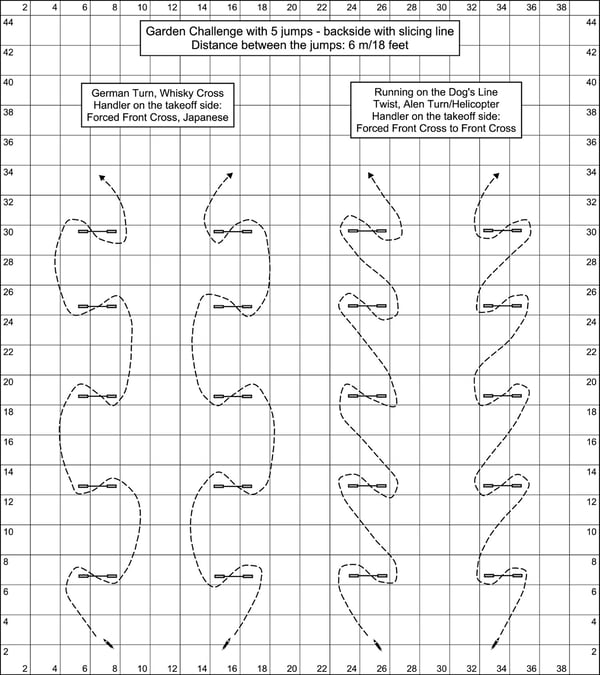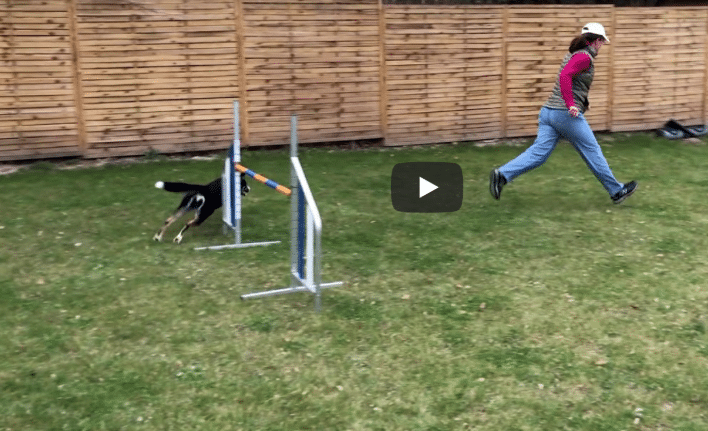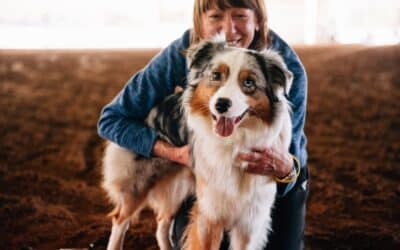Our next training challenge is courtesy of OneMind Dogs Coach Anna Eifert. Anna will walk you through her fun garden challenge in her below article.
Anna’s Garden Challenge
I’m very grateful for having enough space in our garden, and thanks to the beautiful warm spring weather, I mostly spend my quarantine time with gardening and agility. I set up five jumps in a row and started to test my skills.
I first began with the handling techniques, which can create an S-line over backside jumps. I nailed the Whisky Cross, the Twist, and the Japanese, while I was struggling with the Forced Front Cross to a Front Cross and even with my favorite, the German Turn.
Three jumps in a row went usually well, but I failed at the fourth one. It also happened that one side was perfect, but on the other side, I failed at the first jump! That’s why you always have to train both sides. I had 1-3 short sessions per day and didn’t stop until I was able to run back to back, 2×5 times doing each technique with no mistakes.
After I posted a few videos, people started asking me which technique was the fastest. My answer to this is, that it doesn’t matter what my time was with each technique. It’s up to you and your dog, which technique is the best for you in the same situation. Some dogs need motivation and motion; some dogs slow down if you turn your upper body too much towards them; other dogs have a big working distance, or their handler focus is too high.
Also, handlers can have physical restrictions, such as a bad knee for example. In this case, the Japanese is a handy technique. In reality, often the course design also limits your choices. That’s why there is one thing I do care more about than time: my freedom as a handler! I want to be able to create the same line, wherever I am behind or ahead of my dog.
If you have all the tools in your toolbox, there is no limit for you on the course. OneMind Dogs currently uses more than 30 handling techniques, and the first 20 are natural reactions by the dog to the handlers’ cues.
A closer look at the techniques used
The first pattern
The first pattern shows a softer turn after landing. For this line, you can send your dog to the backside and do a Whisky Cross or a German Turn. Or you can already be on the takeoff side, and handle your dog with a Forced Front Cross or a Japanese. The Whisky Cross is a kind of a Rear Cross, which means, you should cross the dog’s line before takeoff. In this case, it’s not entirely possible due to the approach angle; therefore, the German Turn would be a better handling choice for this line on the course.
Everywhere you do a Forced Front Cross, you can do a Japanese too, but the sharper the approach angle is, the more training you and your dog might need. This is a beneficial technique for dogs who slow down when you turn towards them and also very useful for speedy s-lines because you can tell your dog which side of the jump to take while you can run forward with full speed, only turning your head. I love these two techniques! The Forced Front Cross is the first technique I do with puppies on a jump because they react naturally: all the handling elements tell them the same.
In the beginning, I’m arm length from the first wing, but if the dog has enough obstacle focus, I try to have more distance from the jump to be able to get ahead on the course. Nowadays, in Europe, many courses have a backside at the second jump. Quite boring, but easy to do with a Forced Front Cross. If the approach angle is softer and the dog has to turn less, I handle it with a Japanese.
The second pattern
The second pattern shows a tighter exit line. If your dog is knocking too many bars in this situation, the Twist or the Helicopter (Alen Turn) will be very beneficial for you. (Janita has an excellent post about this)
Click the image to get a downloadable course map:

Your turn!
Before you try any of the challenges, I suggest you walk the “course” first, and practice it with your virtual dog. After it feels comfortable, you can try runnng it with your dog. If you need more challenge, don’t use your hands and verbal cues, only the first five handing elements.
If you can tape your sessions, shoot each technique from the front angle, too; you will be
surprised about your dog’s reality line between the jumps!
Here you can see the full playlist of all these eight techniques.
Note: Our times with different techniques were quite similar. In the first pattern, the German Turn gave us the best time, and the Whisky Cross was a little slower than the other techniques. My dog Nebraska is very good at lead changes and has a high obstacle focus, commits to backsides easily, but even for her, getting ahead and moving forward made the time a little bit better.
In the second one, the Forced Front Cross to Front Cross “lost,” and the Helicopter “won.” I guess that move combines everything for her: motion forward, helping the lead changes, and the advantage of the independent backside.



